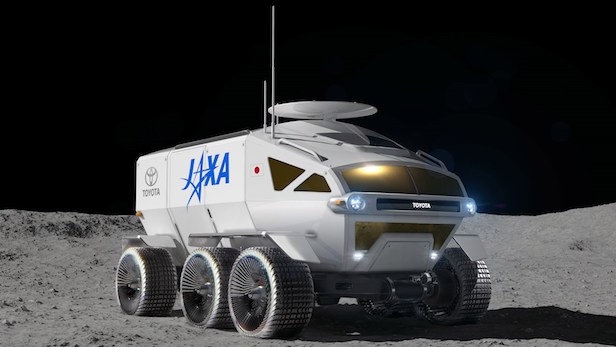Toyota, Japan to launch huge Moon rover for astronauts in 2029
The pressurised vehicle could help astronauts scout for resources such as water ice
A decade or so from now, astronauts could be cruising around the Moon inside a Toyota rover.
The carmaker and the Japan Aerospace Exploration Agency (JAXA) just signed a three-year agreement to jointly develop a pressurised lunar rover, which will incorporate fuel-cell electric-vehicle technologies.
“Over the course of the three-year joint research period, JAXA and Toyota will manufacture, test and evaluate prototypes, with the goal of developing a manned, pressurised lunar rover and exploring the surface of the moon as part of an international project,” Toyota representatives wrote in a 16 July statement.
The agreement runs from June of this year through the end of fiscal year 2021, Toyota representatives added.
Toyota set up a new department called Lunar Exploration Mobility Works on 1 July and plans to have about 30 people working there by the end of the year.
If all goes according to plan, Toyota and JAXA will build a full-scale prototype in the 2022 time frame, design the flight model and build and test an engineering model about two years later, and build and test the flight model around 2027.
Launch would follow in 2029.
“The rover will be used for missions to explore the Moon’s polar regions, with the aim both of investigating the possibility of using the moon’s resources ― such as frozen water ― and of acquiring technologies that enable exploration of the surfaces of massive heavenly bodies,” Toyota representatives wrote in the statement.
There could be a number of customers interested in the Moon rover.
For example, NASA plans to launch two astronauts to the south pole by 2024 and apparently wants to develop a research outpost in the region over the ensuing years. The European Space Agency has similar aims; it would like to help build a south pole “Moon village” in the not-too-distant future.
In addition, a number of private companies plan to mine water ice near the lunar south pole, where the material is abundant on the floors of permanently shadowed craters. This water could be used for life support and, when broken into its constituent hydrogen and oxygen, as rocket fuel.
The Toyota/JAXA vehicle wouldn’t be the first crewed vehicle to roam the lunar surface. NASA launched unpressurised, astronaut-driven “Moon buggies” on the final three Apollo moon missions, in 1971 and 1972.
Keep up to date with the latest news in All About Space – available every month for just £4.99. Alternatively you can subscribe here for a fraction of the price!





